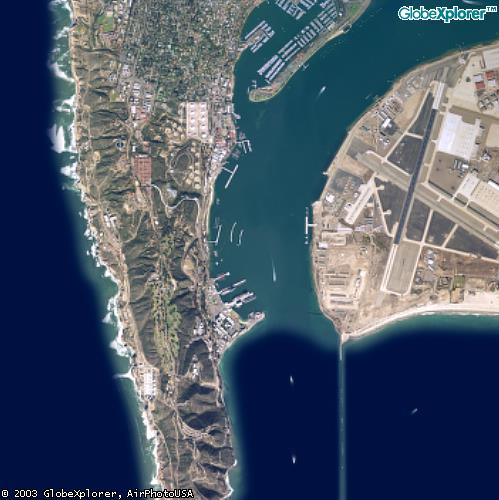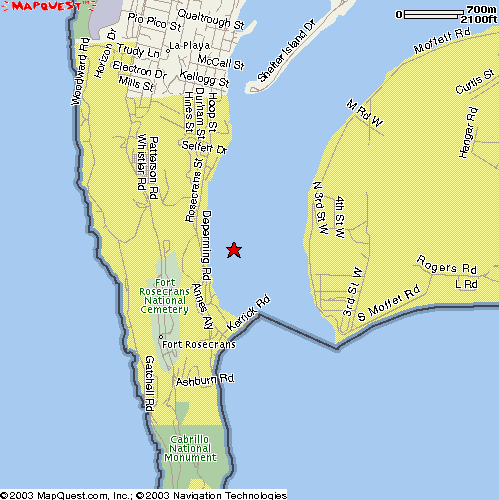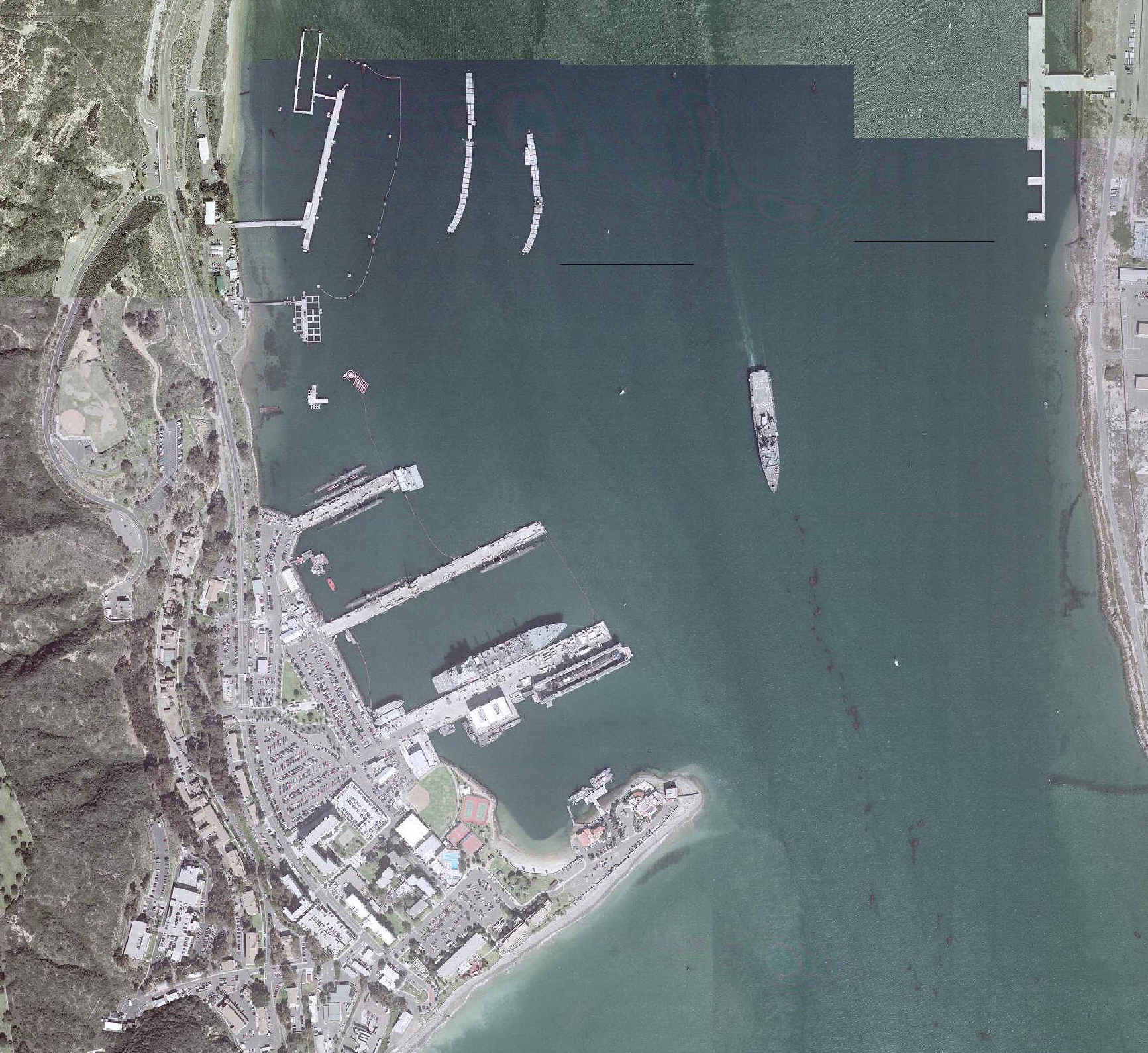EyeballingNaval Submarine Base San Diego


14 February 2003. One of the Eyeball
series.
Source of maps and photos:
Mapquest.com
See also eyeball of North Island Nuclear Weapons Storage Area across the channel: http://cryptome.org/north-eyeball.htm
|
|
 |
 |
 |
|
Source: http://www.access.gpo.gov/su_docs/aces/fr-cont.html
[Federal Register: February 12, 2003 (Volume 68, Number 29)]
[Rules and Regulations]
[Page 7073-7075]
From the Federal Register Online via GPO Access [wais.access.gpo.gov]
[DOCID:fr12fe03-4]
=======================================================================
-----------------------------------------------------------------------
DEPARTMENT OF TRANSPORTATION
Coast Guard
33 CFR Part 165
[COTP San Diego 03-009]
RIN 2115-AA97
Security Zone; San Diego Bay
AGENCY: Coast Guard, DOT.
ACTION: Temporary final rule.
-----------------------------------------------------------------------
SUMMARY: The Coast Guard is temporarily expanding the geographical
boundaries of the permanent security zone at Naval Submarine Base San
Diego, California (33 CFR 165.1103) at the request of the U.S. Navy.
The additional size will accommodate the Navy's placement of anti-small
boat barrier booms on the perimeter of the zone. Entry into this zone
is prohibited unless authorized by the Captain of the Port, the
Commander, Naval Base San Diego, or the Commander, Submarine Force,
U.S. Pacific Fleet Representative, West Coast.
DATES: This rule is effective from 11:59 p.m. on February 11, 2003 to
11:59 p.m. on May 11, 2003.
ADDRESSES: Documents indicated in this preamble as being available in
the docket are part of docket [COTP San Diego 03-009], and are
available for inspection or copying at U.S. Coast Guard Marine Safety
Office San Diego, 2716 N. Harbor Drive, San Diego California 92101,
between 9 a.m. and 4 p.m., Monday through Friday, except Federal
holidays.
FOR FURTHER INFORMATION CONTACT: Lieutenant Commander Rick Sorrell,
Chief of Port Operations, Marine Safety Office San Diego, at (619) 683-
6495.
SUPPLEMENTARY INFORMATION
Regulatory Information
We did not publish a notice of proposed rulemaking (NPRM) for this
temporary regulation. Under 5 U.S.C.
[[Page 7074]]
553(b)(B), the Coast Guard finds that good cause exists for not
publishing an NPRM. While the Navy has been implementing many force
protection measures since the attack on the U.S.S. Cole and the attacks
of September 11, 2001, the Chief of Naval Operations has recently
emphasized the need for the expanded use of anti-small boat barrier
booms around Navy vessels in U.S. ports to protect against attacks
similar to the one launched against the U.S.S. Cole. In addition, the
Office of Homeland Security through its Web site has described the
current nationwide threat level as ``Elevated.'' According to the
Office of Homeland Security, an Elevated Condition is declared when
there is a significant risk of terrorist attacks. The Coast Guard
believes that issuing an NPRM and thereby delaying implementation of
the expanded security zone would be against the public interest during
this elevated state of alert.
Although we had anticipated using the effective period of the
current temporary final rule to engage in notice and comment
rulemaking, the Captain of the Port has decided to extend the effective
period for 3 months to allow sufficient time to properly develop
permanent regulations tailored to the present and foreseeable security
environment. This extension preserves the status quo within the Port
while a permanent rule is developed.
For the reasons stated in the paragraphs above under 5 U.S.C. 553
(d)(3), the Coast Guard also finds that good cause exists for making
this regulation effective less than 30 days after publication in the
Federal Register. Any delay in implementing this rule would be contrary
to the public interest since immediate action is necessary to ensure
the protection of the Naval vessels, their crew, and national security.
Furthermore, in order to protect the interests of national
security, the Coast Guard is promulgating this temporary regulation to
provide for the safety and security of U.S. Naval vessels in the
navigable waters of the United States. As a result, the establishment
and enforcement of this security zone is a function directly involved
in and necessary to military operations. Accordingly, based on the
military function exception set forth in the Administrative Procedure
Act, 5 U.S.C. 553(a)(1), notice and comment rule-making and advance
publication, pursuant to 5 U.S.C. 553(b) and (d), are not required for
this regulation.
The Coast Guard has plans to make the expansion of the security
zone permanent. Towards that end, the Coast Guard will initiate notice
and comment rulemaking before issuing any final rule.
Background and Purpose
The Coast Guard is expanding the current security zone (33 CFR
165.1103) to allow the U.S. Navy to put anti-small boat barrier booms
at Naval Submarine Base San Diego. The expansion of this security zone
is needed to ensure the physical protection of naval vessels moored in
the area by providing adequate standoff distance. The expansion of this
security zone will also prevent recreational and commercial craft from
interfering with military operations involving all naval vessels home-
ported at Naval Submarine Base San Diego and it will protect transiting
recreational and commercial vessels, and their respective crews, from
the navigational hazards posed by such military operations. In
addition, the Navy has been reviewing all aspects of its anti-terrorism
and force protection posture in response to the attack on the USS COLE
and the terrorist attacks of September 11, 2001. The expansion of this
security zone will safeguard vessels and waterside facilities from
destruction, loss, or injury from sabotage or other subversive acts,
accidents, or other causes of a similar nature. Entry into, transit
through, or anchoring within this security zone is prohibited unless
authorized by the Captain of the Port, Commander, U.S. Naval Base San
Diego, or the Commander, Submarine Force, U.S. Pacific Fleet
Representative, West Coast. Vessels or persons violating this section
would be subject to the penalties set forth in 50 U.S.C. 192 and 18
U.S.C. 3571: Seizure and forfeiture of the vessel, a monetary penalty
of not more than $250,000, and imprisonment for not more than 10 years.
The U.S. Coast Guard may be assisted in the patrol and enforcement of
this security zone by the U.S. Navy.
[Federal Register: February 12, 2003 (Volume 68, Number 29)]
[Rules and Regulations]
[Page 7078-7080]
From the Federal Register Online via GPO Access [wais.access.gpo.gov]
[DOCID:fr12fe03-6]
-----------------------------------------------------------------------
DEPARTMENT OF TRANSPORTATION
Coast Guard
33 CFR Part 165
[COTP San Diego 03-007]
RIN 2115-AA97
Security Zone; San Diego Bay
AGENCY: Coast Guard, DOT.
ACTION: Temporary final rule.
-----------------------------------------------------------------------
SUMMARY: The Coast Guard is temporarily expanding the geographical
boundaries of the permanent security zone at Naval Base, San Diego,
California (33 CFR 165.1101), extending it by approximately 80 feet
seaward of the pier heads at the request of the U.S. Navy. The
additional size will accommodate the Navy's placement of anti-small
boat barrier booms perpendicular to the piers. Entry into this zone is
prohibited unless authorized by the Captain of the Port (COTP) San
Diego, or his designated representative.
DATES: This rule is effective from 11:59 p.m. on February 11, 2003 to
11:59 p.m. on May 11, 2003.
ADDRESSES: Documents indicated in this preamble as being available in
the docket are part of docket [COTP San Diego 03-007] and are available
for inspection or copying at U.S. Coast Guard Marine Safety Office San
Diego, 2716 N. Harbor Drive, San Diego California 92101, between 9 a.m.
and 4 p.m., Monday through Friday, except Federal holidays.
FOR FURTHER INFORMATION CONTACT: Lieutenant Commander Rick Sorrell,
Chief of Port Operations, Marine Safety Office San Diego at (619) 683-
6495.
SUPPLEMENTARY INFORMATION:
Regulatory Information
We did not publish a notice of proposed rulemaking (NPRM) for this
temporary regulation. Under 5 U.S.C. 553(b)(B), the Coast Guard finds
that good cause exists for not publishing an NPRM. While the Navy has
been implementing many force protection measures since the attack on
the U.S.S. Cole and the attacks of September 11, 2001, the Chief of
Naval Operations has recently emphasized the need for the expanded use
of anti-small boat barrier booms around Navy vessels in U.S. ports to
protect against attacks similar to the one launched against the U.S.S.
Cole. In addition, the Office of Homeland Security through its Web site
has described the current nationwide threat level as ``Elevated.''
According to the Office of Homeland Security, an Elevated Condition is
declared when there is a significant risk of terrorist attacks. The
Coast Guard believes that issuing an NPRM and thereby delaying
implementation of the expanded security zone would be against the
public interest during this elevated state of alert.
Although we had anticipated using the effective period of the
current temporary final rule to engage in notice and comment
rulemaking, the Captain of the Port has decided to extend the effective
period for 3 months to allow sufficient time to properly develop
permanent regulations tailored to the present and foreseeable security
environment. This extension preserves the status quo within the Port
while a permanent rule is developed.
For the reasons stated in the paragraphs above under 5 U.S.C. 553
(d)(3), the Coast Guard also finds that good cause exists for making
this regulation effective less than 30 days after publication in the
Federal Register. Any delay in implementing this rule would be contrary
to the public interest since immediate action is necessary to ensure
the protection of the Naval vessels, their crew, and national security.
Furthermore, in order to protect the interests of national
security, the Coast Guard is promulgating this temporary regulation to
provide for the safety and security of U.S. Naval vessels in the
navigable waters of the United States. As a result, the establishment
and enforcement of this security zone is a function directly involved
in and necessary to military operations. Accordingly, based on the
military function exception set forth in the Administrative Procedure
Act, 5 U.S.C. 553(a)(1), notice and comment rule-making and advance
publication, pursuant to 5 U.S.C. 553(b) and (d), are not required for
this regulation.
The Coast Guard has plans to make the expansion of the security
zone permanent. Towards that end, the Coast Guard will initiate notice
and comment rulemaking before issuing any final rule.
Background and Purpose
The Coast Guard is expanding the security zone (33 CFR 165.1101) by
temporarily extending it approximately 80 feet seaward of the pier
heads to allow the U.S. Navy to deploy anti-small boat barrier booms
perpendicular to the piers. The expansion of this security zone is
needed to ensure the physical protection of naval vessels moored in the
area by providing adequate standoff distance. It will also prevent
recreational and commercial craft from interfering with military
operations involving all naval vessels home-ported at Naval Base San
Diego and it will protect transiting recreational and commercial
vessels and their respective crews from the navigational hazards posed
by such military operations. In addition, the Navy has been reviewing
all aspects of its anti-terrorism and force protection posture in
response to the attack on the USS COLE and the terrorist attacks of
September 11, 2001. The expansion of this security zone will safeguard
vessels and waterside facilities from destruction, loss, or injury from
sabotage or other subversive acts, accidents, or other causes of a
similar nature. Entry into, transit through, or anchoring within this
security zone is prohibited unless authorized by the Captain of the
Port or Commander, Navy Region Southwest. Vessels or persons violating
this section would be subject to the penalties set forth in 50 U.S.C.
192 and 18 U.S.C. 3571: seizure and forfeiture of the vessel, a
monetary penalty of not more than $250,000, and imprisonment for not
more than 10 years. The U.S. Coast Guard may be assisted in the patrol
and enforcement of this security zone by the U.S. Navy.
[Federal Register: February 12, 2003 (Volume 68, Number 29)]
[Rules and Regulations]
[Page 7075-7078]
From the Federal Register Online via GPO Access [wais.access.gpo.gov]
[DOCID:fr12fe03-5]
-----------------------------------------------------------------------
DEPARTMENT OF TRANSPORTATION
Coast Guard
33 CFR Part 165
[COTP San Diego 03-008]
RIN 2115-AA97
Security Zone; San Diego Bay
AGENCY: Coast Guard, DOT.
ACTION: Temporary final rule.
-----------------------------------------------------------------------
SUMMARY: The Coast Guard is temporarily expanding the geographical
boundaries of the permanent security zone at Naval Base Coronado,
California at the request of the U.S. Navy. The
[[Page 7076]]
additional size will accommodate the Navy's placement of anti-small
boat barrier booms within the zone. Entry into this zone is prohibited
unless authorized by the Captain of the Port (COTP) San Diego, the
Commander, Naval Air Force, U.S. Pacific Fleet, the Commander, Navy
Region Southwest, or the Commanding Officer, Naval Base Coronado.
DATES: This rule is effective from 11:59 p.m. on February 11, 2003 to
11:59 p.m. on May 11, 2003.
ADDRESSES: Documents indicated in this preamble as being available in
the docket, are part of docket [COTP San Diego 03-008], and are
available for inspection or copying at U.S. Coast Guard Marine Safety
Office San Diego, 2716 N. Harbor Drive, San Diego California 92101,
between 9 a.m. and 4 p.m., Monday through Friday, except Federal
holidays.
FOR FURTHER INFORMATION CONTACT: Lieutenant Commander Rick Sorrell,
Chief of Port Operations, Marine Safety Office San Diego, at (619) 683-
6495.
SUPPLEMENTARY INFORMATION
Regulatory Information
We did not publish a notice of proposed rulemaking (NPRM) for this
temporary regulation. Under 5 U.S.C. 553(b)(B), the Coast Guard finds
that good cause exists for not publishing an NPRM. While the Navy has
been implementing many force protection measures since the attack on
the U.S.S. Cole and the attacks of September 11, 2001, the Chief of
Naval Operations has recently emphasized the need for the expanded use
of anti-small boat barrier booms around Navy vessels in U.S. ports to
protect against attacks similar to the one launched against the U.S.S.
Cole. In addition, the Office of Homeland Security through its web site
has described the current nationwide threat level as ``Elevated.''
According to the Office of Homeland Security, an Elevated Condition is
declared when there is a significant risk of terrorist attacks. The
Coast Guard believes that issuing an NPRM and thereby delaying
implementation of the expanded security zone would be against the
public interest during this elevated state of alert.
Although we had anticipated using the effective period of the
current temporary final rule to engage in notice and comment
rulemaking, the Captain of the Port has decided to extend the effective
period for 3 months to allow sufficient time to properly develop
permanent regulations tailored to the present and foreseeable security
environment. This extension preserves the status quo within the Port
while a permanent rule is developed.
For the reasons stated in the paragraphs above under 5 U.S.C. 553
(d)(3), the Coast Guard also finds that good cause exists for making
this regulation effective less than 30 days after publication in the
Federal Register. Any delay in implementing this rule would be contrary
to the public interest since immediate action is necessary to ensure
the protection of the Naval vessels, their crew, and national security.
Furthermore, in order to protect the interests of national
security, the Coast Guard is promulgating this temporary regulation to
provide for the safety and security of U.S. Naval vessels in the
navigable waters of the United States. As a result, the establishment
and enforcement of this security zone is a function directly involved
in and necessary to military operations. Accordingly, based on the
military function exception set forth in the Administrative Procedure
Act, 5 U.S.C. 553(a)(1), notice and comment rule-making and advance
publication, pursuant to 5 U.S.C. 553(b) and (d), are not required for
this regulation.
The Coast Guard has plans to make the expansion of the security
zone permanent. Towards that end, the Coast Guard will initiate notice
and comment rulemaking before issuing any final rule.
Background and Purpose
The Coast Guard is expanding the security zone to allow the U.S.
Navy to put in place anti-small boat barrier booms at Naval Base
Coronado. The expansion of this security zone is needed to ensure the
physical protection of naval vessels moored in the area by providing
adequate standoff distance. The expansion of this security zone will
also prevent recreational and commercial craft from interfering with
military operations involving all naval vessels home-ported at Naval
Base Coronado and it will protect transiting recreational and
commercial vessels, and their respective crews, from the navigational
hazards posed by such military operations. In addition, the Navy has
been reviewing all aspects of its anti-terrorism and force protection
posture in response to the attack on the U.S.S. Cole and the terrorist
attacks of September 11, 2001. The expansion of this security zone will
safeguard vessels and waterside facilities from destruction, loss, or
injury from sabotage or other subversive acts, accidents, or other
causes of a similar nature. Entry into, transit through, or anchoring
within this security zone is prohibited unless authorized by the
Captain of the Port, Commander, Naval Air Force, U.S. Pacific Fleet,
the Commander, U.S. Naval Base San Diego, or the Commander, Naval Base
Coronado. Vessels or persons violating this section would be subject to
the penalties set forth in 50 U.S.C. 192 and 18 U.S.C. 3571: seizure
and forfeiture of the vessel, a monetary penalty of not more than
$250,000, and imprisonment for not more than 10 years. The U.S. Coast
Guard may be assisted in the patrol and enforcement of this security
zone by the U.S. Navy.